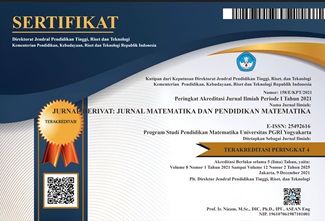Pengembangan Media Pembelajaran Pop-Up Book Etnomatematika Untuk Meningkatkan Kemampuan Literasi Numerasi Siswa
DOI:
https://doi.org/10.31316/jderivat.v10i3.5360Abstract
The cause of the low level of education in Indonesia, especially in students' literacy and numeracy skills, is the limited learning media used in schools. The aim of this research is to develop Pop-Up Book-based learning media to improve the literacy and numeracy skills of students at SD Negeri Cisarua 01, Bogor Regency. The ADDIE model consisting of the stages of Analysis, Design, Development, Implementation, and Evaluation is used as a research method. The data analysis technique used is the descriptive analysis technique. The data analyzed includes media suitability data from media experts and material experts as well as responses from students as test subjects. This Pop-Up Book media has a material validity level of 80%, and media validity of 88%. The effectiveness of the Pop-Up Book learning media from the students' pre-test and post-test showed that the value of tcount > ttable (12.786 > 2.056) and was significant 0.000 < 0.05, so Ha was accepted and Ho was rejected. So it can be concluded that there is a significant difference in learning outcomes before and after the application of Pop-Up Book-based learning media in the introduction of plane shapes and space shapes. To see the increase in the calculated Gain Test, the average result obtained was 0.6688 and was in the medium category. Based on the results of the analysis that has been carried out, it can be concluded that the development of Pop-Up Book learning media can improve the numeracy literacy skills of students at SD Negeri Cisarua 01, Bogor Regency.
Keywords: Numeracy Literacy Skills, Ethnomathematics, Learning Media, Pop-Up Book.
References
Alberta. (2018). Literacy and Numeracy Progressions. (https://education.alberta.ca/literacy-and-numeracy/).
Damarratih, R., Nurzulifa, S., Hastiningrum, D., Dwi G, N., Asriani, F., dan Walid. 2019. Math Pop-Up Comic Book: Media Pembelajaran Matematika Untuk Siswa Penderita Autisme. PRISMA, Prosiding Seminar Nasional Matematika 2. pp.206-219.
Faizah, S.N., Munadzifah, L., dan Khairiyah, U. 2021. Pengembangan media pop-up book pada materi bangun datar. Jurnal Pancar (Pendidik Anak Cerdas Dan Pintar). 5(2):132-137.
Fauzi, A., & Lu’luilmaknun, U. (2019). Etnomatematika Pada Permainan Dengklaq Sebagai Media Pembelajaran Matematika. AKSIOMA: Jurnal Program Studi Pendidikan Matematika, 8(3), 408. https://doi.org/10.24127/ajpm.v8i3.2303
Nugraha, F. A., Nur’aeni, E., Suryana, Y., & Muharram, M. R. W. (2021). Efektivitas Media Powerpoint dalam Pembelajaran Materi Luas Daerah Segitiga untuk Meningkatkan Minat Belajar Peserta Didik di Sekolah Dasar. Edukatif : Jurnal Ilmu Pendidikan, 3(5), 2760–2768.
Paulina, W., Muslihah, N. N., & Nuriyanti, R. (2021). Analisis Penggunaan Media Pop Up Book Dalam Pembelajaran Matematika. CaXra: Jurnal Pendidikan Sekolah Dasar, 1(1), 8–12. https://doi.org/10.31980/caxra.v1i1.1175
Salsabila, S. Z., Agustina, L., & Nurrahmah, A. (2022). Eksplorasi Etnomatematika pada Makanan Tradisional di Kota Depok (Studi Kasus: Kue Balok khas Jawa Barat). Jurnal Pendidikan Dan Konseling (JPDK), 4(6), 10364–10378.
Sapriyah. (2019). Pembelajaran Dalam Proses Belajar Mengajar. Prosiding Seminar Nasional Pendidikan FKIP, 2(1), 470–477.
Setyawan, I. A. (2020). Penguatan literasi di era digital. Prosiding Seminar Nasional PBSI-III Tahun 2020, 35–38.
Sujana, I. W. C. (2019). Fungsi Dan Tujuan Pendidikan Indonesia. Adi Widya: Jurnal Pendidikan Dasar, 4(1), 29. https://doi.org/10.25078/aw.v4i1.927
Yuwono, T., Ningrum, A. D. I., & Susilo, D. A. (2021). Pengembangan Media Pembelajaran Pop Up Book Berbasis Discovery Learning Membuktikan Luas Dan Keliling Lingkaran. AKSIOMA: Jurnal Program Studi Pendidikan Matematika, 10(2), 479. https://doi.org/10.24127/ajpm.v10i2.3091
Downloads
Published
Issue
Section
Citation Check
License
Copyright (c) 2023 Trisha Hana Maulidya, Adi Mulyono, Aqilah Balqis Safitri, Mufliha Dzahabiyyah, Rika Rahmawati, Arfatin Nurrahmah, M.Pd

This work is licensed under a Creative Commons Attribution-ShareAlike 4.0 International License.
Authors who publish with this journal agree to the following terms:
-
Authors retain copyright and grant the journal right of first publication with the work simultaneously licensed under a Creative Commons Attribution-ShareAlike 4.0 International License that allows others to share the work with an acknowledgment of the work's authorship and initial publication in this journal.
- Authors are able to enter into separate, additional contractual arrangements for the non-exclusive distribution of the journal's published version of the work (e.g., post it to an institutional repository or publish it in a book), with an acknowledgment of its initial publication in this journal.
- Authors are permitted and encouraged to post their work online (e.g., in institutional repositories or on their website) prior to and during the submission process, as it can lead to productive exchanges, as well as earlier and greater citation of published work (See The Effect of Open Access).







